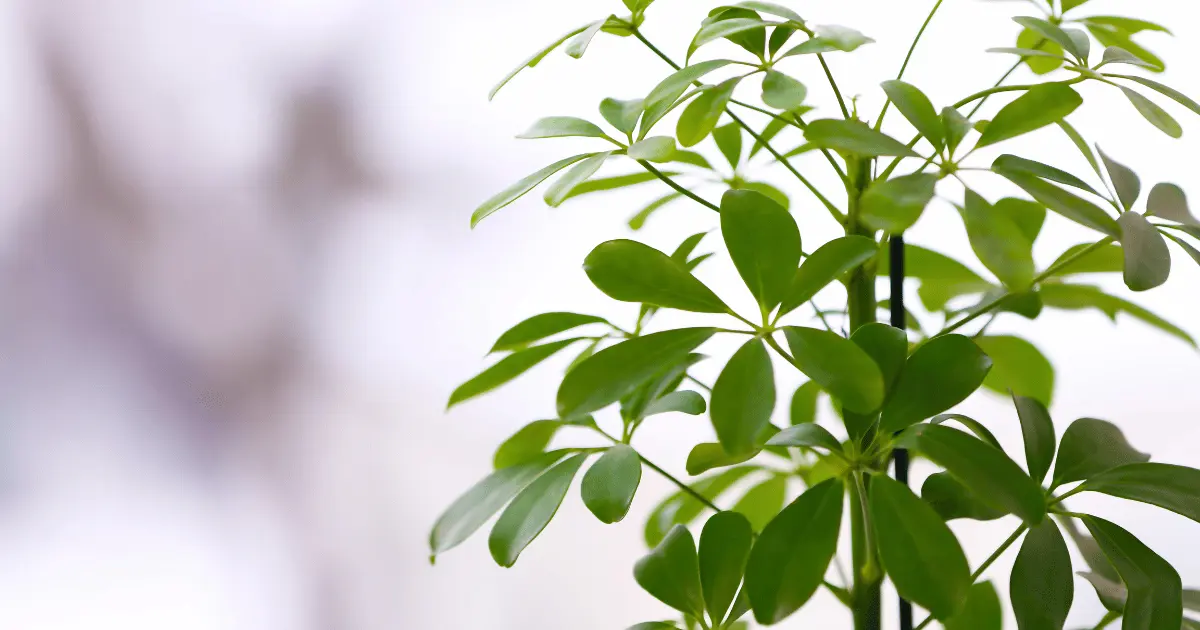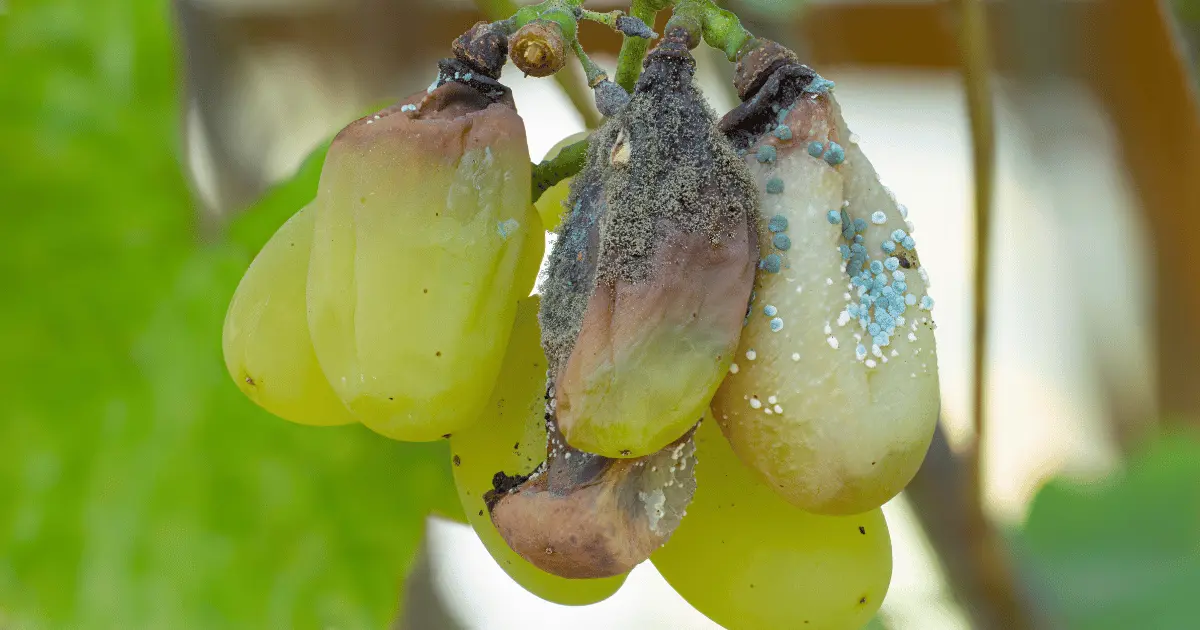Schefflera, also known as the umbrella tree, is a popular houseplant due to its vibrant green foliage and ease of care. However, over time, even the hardiest plants can wilt and lose their luster. If your Schefflera has seen better days, fear not! With a little attention and care, you can revive your plant and restore it to its former glory.
In this article, I will discuss the different factors that can cause the death of a Schefflera plant and provide solutions for reviving it.
Signs of A Dying Schefflera Plant

There are several signs that a Schefflera plant may be dying. These include:
- Yellowing or browning leaves,
- Drooping or wilting foliage.
- Stunted growth.
- The plant may also have dry or brittle stems and a lack of new leaf growth.
If you notice any of these symptoms, taking action quickly is important to revive your Schefflera plant.
How Can I Revive a Dying Schefflera Plant?
To revive a dying Schefflera, you must first identify the cause of the problem. Often, the cause is an external condition that can be corrected if caught in time.
To save your Schefflera plant, you will need to act quickly and follow these steps.
Underwatering
Underwatering is one of the most common reasons a Schefflera plant dies. When a plant doesn’t receive enough water, its leaves will start to droop and wilt, and the plant may become stunted or stop growing altogether. The leaves may also turn yellow or brown, and the stems may become dry and brittle. To prevent underwatering, it’s important to regularly check the soil moisture and water your Schefflera plant whenever the soil feels dry to the touch.
If you suspect your Schefflera plant is suffering from underwatering, you should first water it thoroughly. Ensure to water the plant until the soil is evenly moist and water comes out of the drainage holes in the bottom of the pot. After watering, allow the soil to drain thoroughly, and don’t water again until the soil is dry to the touch. It’s important to avoid overwatering, as this can lead to root rot and other problems.
Overwatering
Overwatering is another common cause of death for Schefflera plants. When a plant is overwatered, the roots cannot access the oxygen they need to survive, which can cause the plant to die. Overwatering can also lead to root rot, a serious problem that can kill a plant. Signs of overwatering include drooping or wilting leaves, yellow or brown leaves, and a lack of new growth.
This can happen when the plant is watered too frequently or when it is watered with too much water at once. As a result, the soil can become waterlogged, and the plant’s roots can begin to rot, leading to various problems. To solve this issue, it’s important to water the plant less frequently and ensure the soil can dry out between watering. Additionally, it’s important to use well-draining soil and to avoid watering the plant from above, as this can cause the water to pool around the base of the plant and can lead to root rot.
Inadequate Light
Another common cause of a dying Schefflera is inadequate light. If your Schefflera plant is not receiving enough light, it may show signs of stunted growth or yellowing leaves. Providing adequate light is essential for the health and vitality of the plant, as it uses light to produce energy through photosynthesis. Here are some possible solutions for addressing inadequate light for your Schefflera plant:
Move the plant to a location where it can receive more light. Schefflera plants prefer bright, indirect light, so a spot near an east- or west-facing window is ideal. Avoid placing the plant in direct sunlight, which can cause leaf scorch or other damage.
If you cannot find a spot where it can receive more light, you can provide additional light using grow lights. Grow lights are artificial light sources designed to mimic the spectrum of sunlight and can be placed near the plant to provide additional light for photosynthesis.
If the plant is receiving some light, but it is not enough, you can increase the intensity of the light by cleaning the plant’s leaves. Over time, dust and debris can accumulate on the leaves, reducing the amount of light that reaches the plant. Gently wipe the leaves with a soft, damp cloth to remove any buildup and increase the amount of light the plant receives.
Pest Infestation
If your Schefflera plant is infested with pests, you should first identify the specific type of pest causing the problem. This can be done by closely inspecting the plant and looking for signs of pests, such as small insect eggs, larvae, or adult insects. Common pests of Schefflera plants include aphids, mealybugs, scale insects, and spider mites.
Once you have identified the pest, you can take steps to control the infestation and prevent further damage to your plant. Here are some possible solutions for dealing with pest-infested Schefflera plants:
If the infestation is minor, you can remove the pests by hand using a soft cloth or cotton swab. Be sure to dispose of the pests properly to prevent them from spreading.
You can use a mild soap solution to kill the pests for larger infestations. Mix a few drops of mild liquid soap with water and apply it directly to the infested areas of the plant.
If the infestation is severe, you may need to use a commercial insecticide to kill the pests. Be sure to follow the instructions on the product label carefully, and avoid using excessive amounts, as this can harm the plant.
Remember to be patient and persistent, as it may take time for the plant to recover fully. If you need help caring for your plant or cannot control the infestation, consulting with a professional or conducting further research for additional guidance is best.
Diseases

If your Schefflera plant is showing signs of disease, there are a few steps you can take to help it recover.
First, it’s important to identify the disease to choose the appropriate treatment correctly. Some common diseases affecting Schefflera plants include root rot, leaf spot, and crown rot.
Root rot is caused by a fungal infection that affects the plant’s roots. It is often caused by overwatering, leading to waterlogged soil and creating conditions conducive to fungal growth. Root rot symptoms include yellowing or wilting leaves, stunted growth, and a foul smell from the soil.
Leaf spot is another common fungal disease that can affect Schefflera plants. It is characterized by small, dark spots on the leaves, which can eventually turn yellow and fall off. Leaf spot is often caused by poor air circulation, high humidity, or excess moisture on the leaves.
Crown rot is another fungal disease that can affect Schefflera plants. It is caused by the same fungi that cause root rot, which can spread from the roots to the base of the plant, eventually killing the entire plant. Symptoms of crown rot include yellowing or wilting leaves, stunted growth, and a foul smell from the soil.
Once you have correctly identified the disease affecting your Schefflera plant, you can take steps to treat it. The first step for root and crown rot is to remove the infected plant from its pot and carefully inspect the roots. If the roots are damaged or blackened, they need to be removed. Use a sharp, sterile knife to carefully cut away the infected roots, not damaging the healthy roots.
Once the infected roots have been removed, re-pot the plant in a new pot with a fresh, sterile potting mix. Be sure to choose a pot with drainage holes to allow excess water to escape, and water the plant carefully to avoid overwatering. You can also treat the plant with a fungicide to help prevent further fungal growth.
For leaf spots, the first step is to improve air circulation and reduce humidity around the plant. This can be done by providing better ventilation and avoiding watering the leaves directly. You can also treat the plant with a fungicide to help prevent further fungal growth.
Pot-bound Problems
If you have a pot-bound Schefflera plant, you can take a few steps to help it thrive.
First, it’s important to understand what it means for a plant to be pot-bound. This refers to a situation in which a plant’s roots have become so crowded and tangled in its current pot that they cannot properly grow and absorb nutrients and water. As a result, the plant may appear stunted or wilted and may have yellowing leaves or reduced blooming.
If you suspect that your Schefflera plant is pot-bound, the first step is to remove it from its current pot carefully. Gently loosen the roots and examine them to see if they are densely packed and tangled. If so, it’s time to re-pot the plant.
To re-pot a Schefflera plant, choose a new pot slightly larger than its current one, with drainage holes to allow excess water to escape. Fill the bottom of the pot with a well-draining potting mix, such as a mix specifically designed for tropical plants. Gently place the Schefflera plant in the pot, and add more potting mix around the roots, gently firming it down to ensure good contact with the roots. Water the plant thoroughly to help the roots settle into their new pot.
It’s important to choose the right size pot for your Schefflera plant. A pot that is too large can lead to overwatering, while a pot that is too small will cause the roots to become pot-bound again. A just right pot will allow the roots to spread out and properly absorb water and nutrients without becoming overcrowded.
Once your Schefflera plant is re-potted, it will likely need some time to adjust to its new pot and potting mix. Be patient and give it the care it needs, including proper watering and adequate light, and it should soon begin to show signs of new growth. Avoid fertilizing the plant for the first few weeks after re-potting, as this can stress the roots and cause further damage.
In addition to re-potting, you can do a few other things to help a pot-bound Schefflera plant. Pruning can help to remove crowded or damaged roots, which can help the plant to grow more freely. You can gently tease the roots with your fingers to help them spread out more evenly in the pot. And be sure to choose a well-draining potting mix and provide adequate light and water to help your plant thrive.
Final Thoughts
Following these steps can help revive a dying Schefflera and bring it back to good health. Regular watering, adequate light, pest control, and proper fertilization are key to keeping your plant healthy and happy. With a little patience and care, you can bring your Schefflera back to life and enjoy its striking foliage for years to come.
